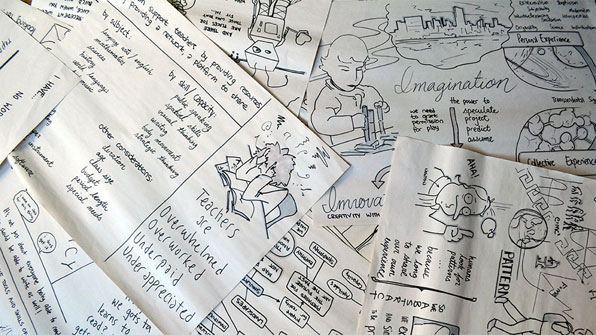Masters Thesis: The Teacher's Lounge, by Joseph Weissgold
Products of Design MFA student Joseph Weissgold has spent the past year exposing the similarities he’s seen between his two background disciplines: Education and Design. Both these disciplines, he argues, are in a state of transformation, shifting from industries focused on optimizing efficiency through mass-produced offerings, to industries focused on experiences that are flexible enough to be personally relevant to their intended audiences—whether users or students.
Using the design strategies and skills he’d developed throughout his higher education, Joseph formulated his “lesson design” method,which he manifested in a variety of media, as a digital application, and a physical workbook. He revised the method over the course of several months, conducting experiments with teachers and other educators. “I knew that I didn’t want to tell teachers how to teach,” Joseph explained, “they know what works with their students better than I ever could.” So his goal was to provide them with a template that would be structured enough to relieve some of the anxiety of the many choices to be made, but open-ended enough that teachers could apply their specific knowledge and interests to the process. This balance of “structure and freedom” would become a central theme in Joseph’s work.
Reflecting upon his own experience as a camp counselor, after-school teacher, and Hebrew school teacher, Joseph recognized the need for working with others in the creative process of lesson design. In his own work, he’d been fortunate enough to often work with partners as well as teams. “That’s when the best ideas emerge,” he offered. But he admitted that this kind of collaboration was a privilege that school-teachers were seldom privy to.
Joseph sought out the opportunities that teachers do have to collaborate, and so entered into a relationship with the Department of Education’s iZone (Innovation Zone). The iZone hosts affinity group meetings for affiliated schools to share best practices around flipped-classrooms, coaching, socio-emotional skills, and many other subjects. Attending these meetings, Joseph noticed that teachers were coming together to learn from each other, but when it came to actually planning, it was still largely a solo task. The exceptions he found to this were independently organized planning groups, predominantly involving teachers of technology or art. In any case, most schools were not providing teachers with the support they needed to successfully apply their professional development to their teaching.
To address this, Joseph organized a workshop, inviting teachers around Prospect Heights and Park Slope to plan lessons together using a design process at their local library—the Central Library at Grand Army Plaza. The workshop totaled three-hours and walked teachers through the method Joseph had developed for Lesson Design. Again, the challenge he faced concerned the balance of structure and freedom. “The feedback I got was that they really wanted more structure. I was reluctant to be too strict with the timing and the order of the things, but in that reluctance I made the workshop too open-ended to be highly productive,” he reflected. “It’s a balance; they wanted me to act as the teacher, but I guess I wanted to present an alternative model of ‘teacher’.”
Joseph plans on running more workshops to find that balance of structure and freedom and to refine his Lesson Design method. He is optimistic that if he can run these workshops on an ongoing basis, it will eventually become his full time occupation. He also is intent on building a database of the lessons that are crafted using his Lesson Design framework and making it available to the public. In the Products of Design program, Joseph was exposed to many alternative business models. He knows that helping teachers bring design and technology into their practice is not a big money-maker, but it’s not money that drives his purpose. Rather, he embodies the values of the sharing-economy, the experience-economy, and the purpose-economy. Supported by online communities and grassroots organization, Joseph hopes to help teachers flourish—as the creative profession that they are.
Read more about the project, including subject matter experts and research protocols in the PDF above. See more of Joseph Weissgold’s work at his website JosephWeissgold.com, and email him at jweissgold[at]gmail[dot]com













